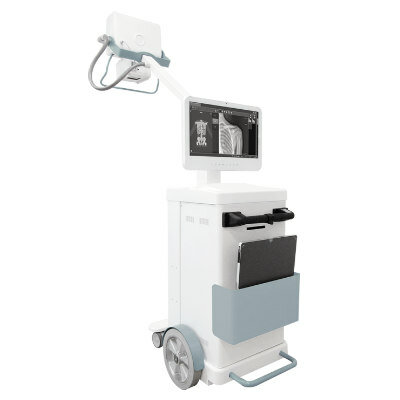Enhanced Ultrasound Superior to MRI for Diagnosing Certain Liver and Kidney Tumors
|
By MedImaging International staff writers Posted on 27 Feb 2023 |

Contrast-enhanced ultrasound (CEUS) is a non-invasive imaging tool that is routinely used across the world to identify and characterize cancers, diagnose heart and vascular disease, monitor chronic gastro-intestinal diseases and therapy. Ultrasound contrast agents are administered intravenously to enhance the images produced by ultrasound scans, enabling the visualization of abnormal microvascular blood flow patterns in real time. Now, two new studies have revealed that CEUS is more accurate and reliable than MRI for examining certain liver and kidney nodules.
The two new studies were highlighted by the International Contrast Ultrasound Society (ICUS, Chicago, IL, USA; www.icus-society.org), a non-profit medical society dedicated to advancing the medically appropriate use of CEUS to improve patient care and outcomes. In the liver CEUS study, which followed 196 patients for two years, the researchers found that CEUS scans are at least equivalent if not superior to MRI for evaluating these liver lesions, and CEUS should be the first investigation for nodules found on surveillance for liver cancer. The study showed that CEUS offers superior sensitivity when compared to MRI (81% vs. 64%) for the diagnosis of malignancy, without compromising specificity (92% vs. 93%). In addition, CEUS was more likely than MRI to reproduce and characterize the nodule found on screening (97% vs. 78.5%). The liver study represents the first prospective comparison of CEUS and contrast-enhanced MRI for assessment of newly-discovered liver nodules. Based on these findings, the researchers have called upon the American Association for the Study of Liver Diseases (AASLD) to include CEUS in its liver imaging guidelines, along with MRI and CT. However, MRI still remains an essential tool for managing patients with malignant tumors, particularly for staging these tumors prior to treatment, according to the researchers.
“We found that CEUS is a better and less expensive first-step evaluation for newly-discovered liver nodules,” said Dr. Stephanie Wilson, principal investigator of the liver CEUS study. “CEUS found malignant or pre-malignant diagnoses that would likely have been missed or delayed if we had not used CEUS in these patients. In addition, CEUS quickly and reliably identified benign lesions and pseudo-lesions, sparing these patients the costs and risks associated with unnecessary downstream testing and procedures.”
Meanwhile, the kidney CEUS study reviewed clinical data over a 10 year period to assess the accuracy of CEUS diagnoses of benign kidney nodules in 341 patients. Their blinded analysis found that none of the CEUS diagnoses changed during that period.
“Our data confirm that when CEUS determines a kidney mass is benign, the mass is benign and no further follow up is needed - sparing the patient from unnecessary downstream tests, anxiety and costs,” according to Dr. Richard G. Barr, the lead author of the kidney CEUS study. “It is important to remember that ultrasound contrast agents do not contain iodinated dye and do not harm the kidneys, making CEUS the examination of choice for patients with renal insufficiency.”
“In addition, CEUS allows for improved visualization of enhancement patterns in real time, the thin slice thickness of CEUS allows for evaluation of small nodules, multiplanar imaging allows for improved visualization and confirmation of enhancement, and multiple doses may be used during the same examination to provide an opportunity to image the lesion thoroughly,” Dr. Barr added. “Further, due to radiation exposure associated with CT, we believe CT should not be used as the first line imaging modality for assessing cystic lesions that are most probably benign in character.”
Related Links:
ICUS
Latest MRI News
- PET/MRI Improves Diagnostic Accuracy for Prostate Cancer Patients
- Next Generation MR-Guided Focused Ultrasound Ushers In Future of Incisionless Neurosurgery
- Two-Part MRI Scan Detects Prostate Cancer More Quickly without Compromising Diagnostic Quality
- World’s Most Powerful MRI Machine Images Living Brain with Unrivaled Clarity
- New Whole-Body Imaging Technology Makes It Possible to View Inflammation on MRI Scan
- Combining Prostate MRI with Blood Test Can Avoid Unnecessary Prostate Biopsies
- New Treatment Combines MRI and Ultrasound to Control Prostate Cancer without Serious Side Effects
- MRI Improves Diagnosis and Treatment of Prostate Cancer
- Combined PET-MRI Scan Improves Treatment for Early Breast Cancer Patients
- 4D MRI Could Improve Clinical Assessment of Heart Blood Flow Abnormalities
- MRI-Guided Focused Ultrasound Therapy Shows Promise in Treating Prostate Cancer
- AI-Based MRI Tool Outperforms Current Brain Tumor Diagnosis Methods
- DW-MRI Lights up Small Ovarian Lesions like Light Bulbs
- Abbreviated Breast MRI Effective for High-Risk Screening without Compromising Diagnostic Accuracy
- New MRI Method Detects Alzheimer’s Earlier in People without Clinical Signs
- MRI Monitoring Reduces Mortality in Women at High Risk of BRCA1 Breast Cancer
Channels
Radiography
view channel
Novel Breast Imaging System Proves As Effective As Mammography
Breast cancer remains the most frequently diagnosed cancer among women. It is projected that one in eight women will be diagnosed with breast cancer during her lifetime, and one in 42 women who turn 50... Read more
AI Assistance Improves Breast-Cancer Screening by Reducing False Positives
Radiologists typically detect one case of cancer for every 200 mammograms reviewed. However, these evaluations often result in false positives, leading to unnecessary patient recalls for additional testing,... Read moreMRI
view channel
PET/MRI Improves Diagnostic Accuracy for Prostate Cancer Patients
The Prostate Imaging Reporting and Data System (PI-RADS) is a five-point scale to assess potential prostate cancer in MR images. PI-RADS category 3 which offers an unclear suggestion of clinically significant... Read more
Next Generation MR-Guided Focused Ultrasound Ushers In Future of Incisionless Neurosurgery
Essential tremor, often called familial, idiopathic, or benign tremor, leads to uncontrollable shaking that significantly affects a person’s life. When traditional medications do not alleviate symptoms,... Read more
Two-Part MRI Scan Detects Prostate Cancer More Quickly without Compromising Diagnostic Quality
Prostate cancer ranks as the most prevalent cancer among men. Over the last decade, the introduction of MRI scans has significantly transformed the diagnosis process, marking the most substantial advancement... Read moreNuclear Medicine
view channel
New SPECT/CT Technique Could Change Imaging Practices and Increase Patient Access
The development of lead-212 (212Pb)-PSMA–based targeted alpha therapy (TAT) is garnering significant interest in treating patients with metastatic castration-resistant prostate cancer. The imaging of 212Pb,... Read moreNew Radiotheranostic System Detects and Treats Ovarian Cancer Noninvasively
Ovarian cancer is the most lethal gynecological cancer, with less than a 30% five-year survival rate for those diagnosed in late stages. Despite surgery and platinum-based chemotherapy being the standard... Read more
AI System Automatically and Reliably Detects Cardiac Amyloidosis Using Scintigraphy Imaging
Cardiac amyloidosis, a condition characterized by the buildup of abnormal protein deposits (amyloids) in the heart muscle, severely affects heart function and can lead to heart failure or death without... Read moreGeneral/Advanced Imaging
view channel
New AI Method Captures Uncertainty in Medical Images
In the field of biomedicine, segmentation is the process of annotating pixels from an important structure in medical images, such as organs or cells. Artificial Intelligence (AI) models are utilized to... Read more.jpg)
CT Coronary Angiography Reduces Need for Invasive Tests to Diagnose Coronary Artery Disease
Coronary artery disease (CAD), one of the leading causes of death worldwide, involves the narrowing of coronary arteries due to atherosclerosis, resulting in insufficient blood flow to the heart muscle.... Read more
Novel Blood Test Could Reduce Need for PET Imaging of Patients with Alzheimer’s
Alzheimer's disease (AD), a condition marked by cognitive decline and the presence of beta-amyloid (Aβ) plaques and neurofibrillary tangles in the brain, poses diagnostic challenges. Amyloid positron emission... Read more.jpg)
CT-Based Deep Learning Algorithm Accurately Differentiates Benign From Malignant Vertebral Fractures
The rise in the aging population is expected to result in a corresponding increase in the prevalence of vertebral fractures which can cause back pain or neurologic compromise, leading to impaired function... Read moreImaging IT
view channel
New Google Cloud Medical Imaging Suite Makes Imaging Healthcare Data More Accessible
Medical imaging is a critical tool used to diagnose patients, and there are billions of medical images scanned globally each year. Imaging data accounts for about 90% of all healthcare data1 and, until... Read more
Global AI in Medical Diagnostics Market to Be Driven by Demand for Image Recognition in Radiology
The global artificial intelligence (AI) in medical diagnostics market is expanding with early disease detection being one of its key applications and image recognition becoming a compelling consumer proposition... Read moreIndustry News
view channel
Bayer and Google Partner on New AI Product for Radiologists
Medical imaging data comprises around 90% of all healthcare data, and it is a highly complex and rich clinical data modality and serves as a vital tool for diagnosing patients. Each year, billions of medical... Read more



















